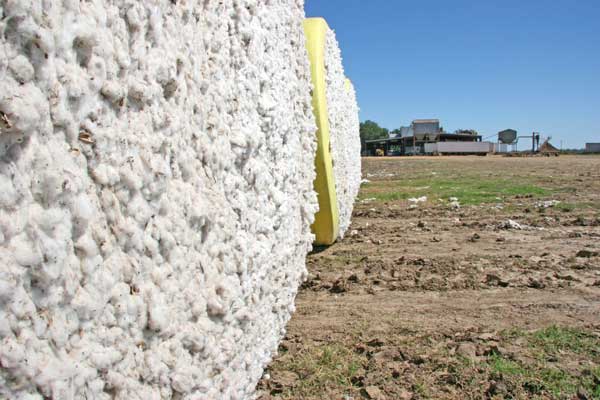
O.A. Cleveland can’t see 90-cent cotton—86 cents a pound, maybe.
“There is not a lot of cotton left in the world outside China,” Cleveland said during the Southwest Cotton Technology and Innovation Conference, sponsored by Bayer CropScience, in Austin, Texas.
“That’s why New York has cotton at 80 cents. Some say 90 cents. I can’t get to 90; 86 cents is my top for new crop Dec. cotton.”
Other cotton-producing countries “are reeling back cotton acreage because of price.”
A large quantity of certified stocks, Cleveland said, is coming to the board. “That keeps pressure on the top of the market.”
Weather could move those numbers. Recent USDA planting estimates put 2013 cotton acreage at 9 million. “About 5 million of that will be in Texas,” Cleveland said. The Mid-South acreage is expected to drop to 1 million acres with only 200,000 in Mississippi.
Production estimate of 12.86 million could dip if drought continues in the Southwest. “Weather analysts suggest the Southwest may be in for five years of drought,” Cleveland said. The region could be in the third year of that cycle now. Southwest cotton growers “need timely rain.”
Without it, production could drop to 10 million or 9.5 million bales. “That could spur prices.” That’s for middling 3/16 or 3/32, Cleveland said.
Quality remains an important issue. And China remains the market catalyst.
“Analysts tell us that demand is not there,” Cleveland added. “They cite a downturn in China spinning. But China was still weaving and knitting. They were importing yarn, especially from Pakistan.”
A lot of reports did not consider the amount of yarn coming into China, as much as 8.3 million bales worth of yarn. “That’s up from 1 million bales five years ago.”
Cleveland said China imported close to 22 million bales of cotton, including the yarn and 14 million bales of raw cotton. “They need a lot of cotton to keep the textile industry going.”
It gets more complicated. The Chinese government buys cotton directly from the country’s growers. The government has purchased the entire cotton crop for the past two years. “That does not occur with any other commodity in China,” Cleveland said.
Chinese government actions
Production cost for Chinese cotton farmers is $1.20 to $1.45 per pound. “It’s highly mechanized in the major production region, not as much in the larger areas of production,” Cleveland said. “Labor costs are big and availability of labor is a factor.”
Chinese government leaders, he said, will move small cotton farms off the east coast and into areas that are highly mechanized. They plan to move grain production to the Southeast and East. “That’s a major change.”
Despite recent big crops, cotton prices have not dipped into the 40-cent range. “Mills can’t get cotton out of China. But mills in China can buy U.S. cotton, and they are better off buying and spinning U.S. cotton which is longer and stronger than what Chinese mills can buy from their government.” That’s because the government is not putting quality cotton on the market. They’ve been selling off surplus from old crops, 2005 and then later crops. “They do have better cotton,” Cleveland said.
China’s textile industry is strong, but the government is making it difficult for the mills to spin cotton. “They like polyester. Price is down to 50 cents to 66 cents a pound. Cotton is $1.40 cents, so China is encouraging the use of polyester. That’s not the same with Pakistan and other countries.”
Cleveland says cotton is seeing good retail activity and strong consumer demand, even with huge world stocks. Production figures at 117 million bales and consumption of 106 million leave an 11 million-bale carryout; added to an already large supply that creates the largest carryout ever, about 82 million bales, Cleveland said. “We used to think a 50 million-bale carryout was big.”
Again, China holds the key. “China’s government owns 53 million of those bales.”
Cleveland also noted an increase in consumption, an increase in U.S. exports, and an increase in international trade. U.S. cotton exports are now estimated at 12.5 million bales, up from 12.2 million the first of February and 11.8 million expected earlier. “That’s a significant increase and denotes demand for U.S. cotton is extremely strong and will remain strong.”
A lot can still happen. Cleveland quoted Yogi Berra to illustrate the uncertainty of cotton markets. “Predicting is extremely difficult, especially when it’s about the future.”
Cotton markets and famers can’t know what weather will do in 2013, but Cleveland advises Texas farmers: “Don’t sell the cotton picker. The best alternative to cotton in Texas is more cotton.”
And market opportunities look promising. “We should spend a lot of time in the 80s,” he said, “and maybe some in the 90s and may slip into the high 70-cent range.”
He also encouraged cotton farmers to consider the value of cottonseed as they make planting decisions. “The price of cottonseed will follow the oilseeds, especially soybeans,” he said. “That’s part of cotton income.”
At current oilseed prices, cottonseed could add another $50 a bale to revenues.
About the Author(s)
You May Also Like






